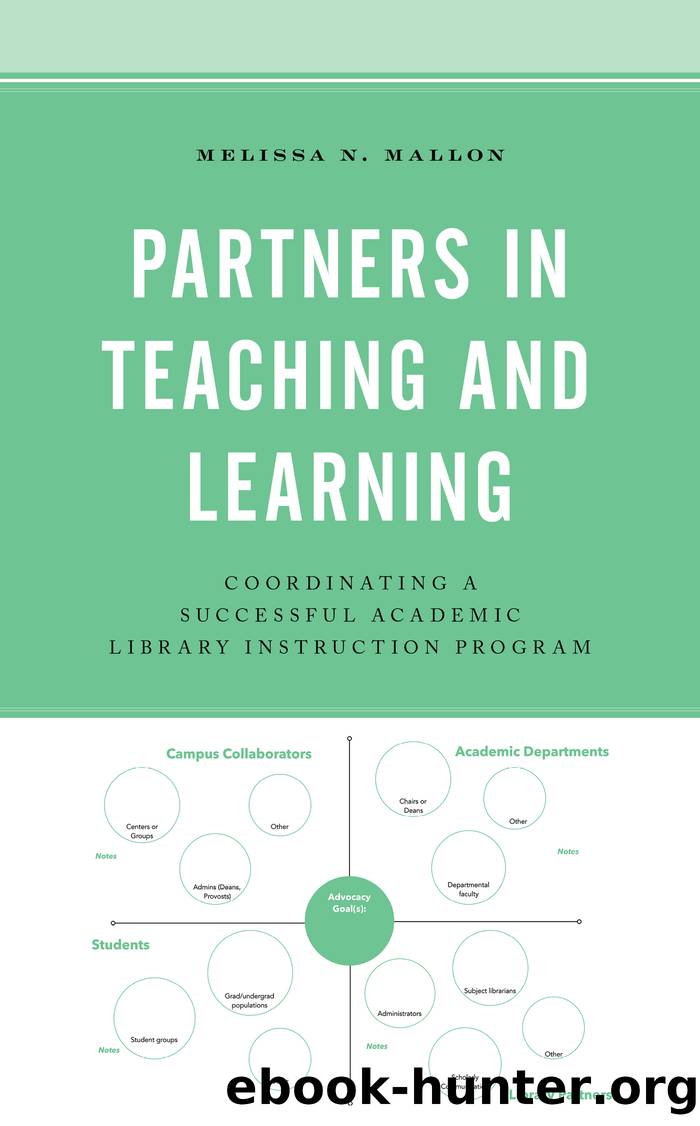Partners in Teaching and Learning by Melissa N. Mallon;

Author:Melissa N. Mallon;
Language: eng
Format: epub
Tags: undefined
Publisher: Rowman & Littlefield Publishing Group, Inc.
Published: 2012-06-15T00:00:00+00:00
Other Campus Collaborators
It is important to note that library instruction efforts can (and most definitely should!) stretch beyond the academic curriculum. Just as curriculum mapping aligns information literacy instruction to departmental and program outcomes (more about this next), teaching and learning efforts can be mapped to co-curricular initiatives on campus, such as student success, athletics, or residential life. The ACRL Roles and Strengths document highlights the opportunity for librarians to engage in information literacy instruction beyond the classroom: âlibrarian leaders model instructional best practices as well as continuous learning and growth, facilitate the sharing of pedagogical ideas and experiences, and support teaching and learning efforts across disciplines and co-curricular areasâ (Amsberry et al., 2017, para. 15).
Identifying other campus partners that also focus on student learning is a way to stretch the reach of an information literacy instruction program, whether through direct student instruction or via other methods. Librarians at Vanderbilt University, for example, found that collaborating with the Department of Athleticsâ Academic Support Center provided the perfect opportunity to approach information literacy instruction. Together they developed a train-the-trainer program for athletic counselors because: âgiven the counselorsâ regular contact with the student athletes, the librarians believed the counselors were in a position to reinforce the libraryâs role in student successâ (Costin & Morgan, 2019, p. 224).
Catching students in co-curricular environments is another influential way to advocate for the value of librarians and the development of digital, information, or other literacies. Although it can be difficult to identify the types and the frequency of student involvement in co-curricular activities, Lyle, Fournier, Phuwanartnurak, Lewis, and Roberts (2016) suggest that better communication among campus partners can increase the reach of co-curricular opportunities for students, particularly residential students. These partnerships will look different on every campus, depending on institutional size and organization. Some of the offices to investigate for advocacy efforts include those focusing on student learning and success (e.g., academic affairs; advising; or residential and campus life), as well as those focusing on faculty development and teaching (e.g., centers for teaching; instructional designers; or an educational technologies/digital learning department). Campus partners can also rely on one another for promoting research workshops and other instructional programming (Lyle, Fournier, Phuwanartnurak, Lewis, & Roberts, 2016).
Download
This site does not store any files on its server. We only index and link to content provided by other sites. Please contact the content providers to delete copyright contents if any and email us, we'll remove relevant links or contents immediately.
| Arts & Humanities | Health |
| Language Arts | Library Skills |
| Mathematics | Reading & Phonics |
| Science & Technology | Social Studies |
The Art of Coaching Workbook by Elena Aguilar(50130)
Trainspotting by Irvine Welsh(21050)
Twilight of the Idols With the Antichrist and Ecce Homo by Friedrich Nietzsche(18312)
Fangirl by Rainbow Rowell(8807)
Periodization Training for Sports by Tudor Bompa(7936)
Change Your Questions, Change Your Life by Marilee Adams(7389)
This Is How You Lose Her by Junot Diaz(6463)
Asking the Right Questions: A Guide to Critical Thinking by M. Neil Browne & Stuart M. Keeley(5369)
Grit by Angela Duckworth(5303)
Red Sparrow by Jason Matthews(5204)
Paper Towns by Green John(4812)
Room 212 by Kate Stewart(4745)
Ken Follett - World without end by Ken Follett(4453)
The Sports Rules Book by Human Kinetics(4087)
Housekeeping by Marilynne Robinson(4075)
Double Down (Diary of a Wimpy Kid Book 11) by Jeff Kinney(3941)
Papillon (English) by Henri Charrière(3924)
The Motorcycle Diaries by Ernesto Che Guevara(3796)
Exercise Technique Manual for Resistance Training by National Strength & Conditioning Association(3791)
